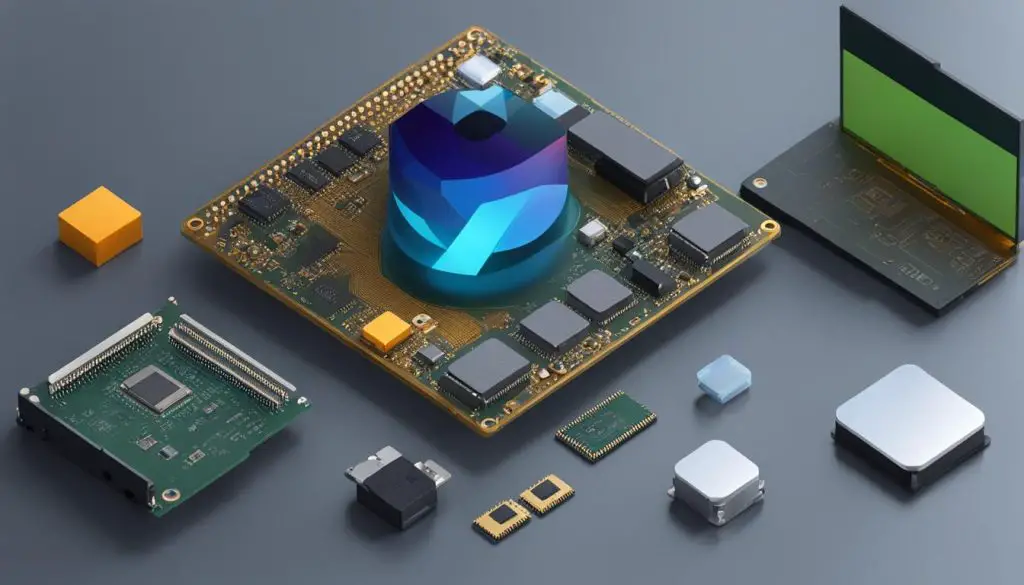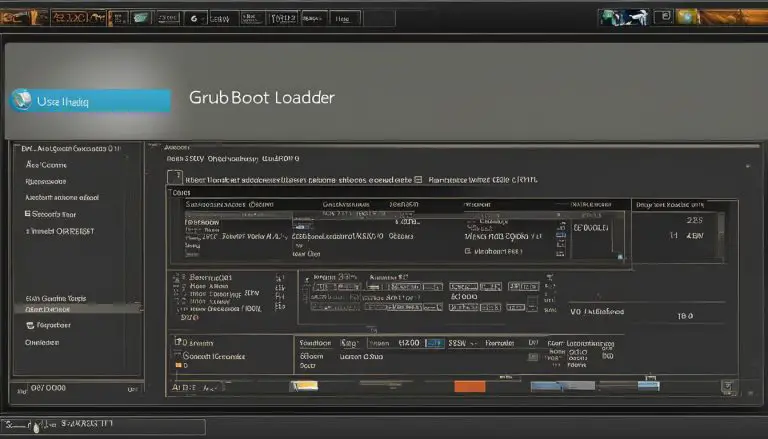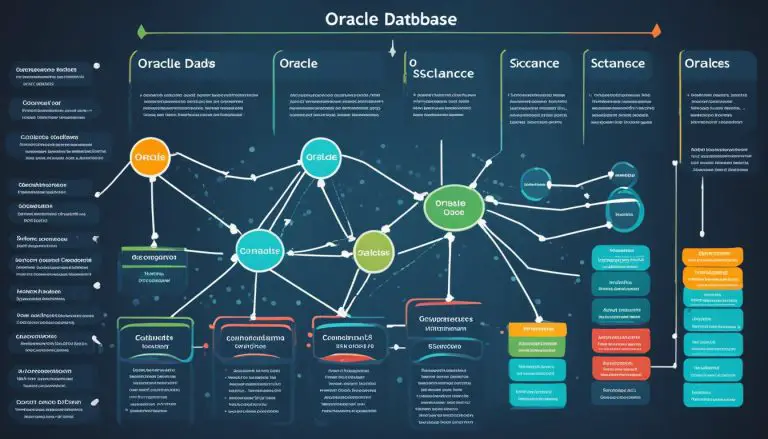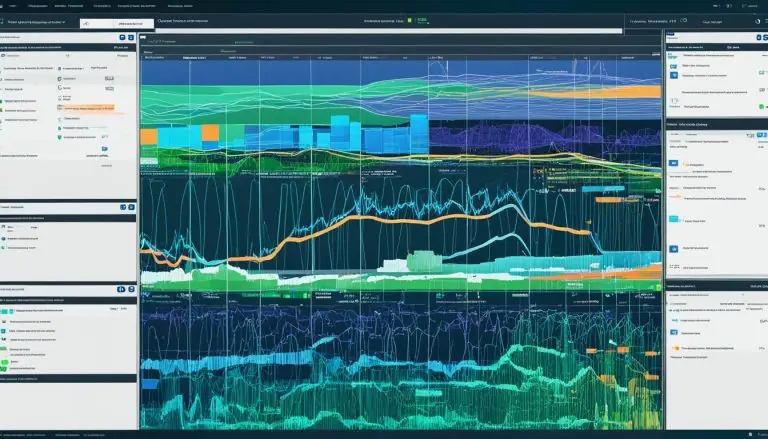Understanding What is KDE (K Desktop Environment) in Detail
KDE (K Desktop Environment) is a free desktop environment and development platform built with Trolltech’s Qt toolkit. It aims to provide the best graphical interface between humans and the information stored on computers, offering consistency, clarity in actions, and customization options to enhance the user experience. With its focus on latency concerns and a wide range of applications for office productivity and software development, KDE is a versatile and user-friendly choice for desktop environments.
Key Takeaways:
- KDE (K Desktop Environment) is a free desktop environment and development platform.
- KDE aims to provide a user-friendly interface and customization options.
- KDE offers a wide range of applications for office productivity and software development.
- KDE focuses on consistency, clarity in actions, and customization options to enhance the user experience.
- Installing KDE is relatively straightforward, and it has modest system requirements.
The Origins of KDE
The KDE desktop environment has a rich history that dates back to its inception in 1996. It was founded by Matthias Ettrich with the aim of creating a user-friendly and consistent desktop environment for Unix-based systems. Ettrich’s motivation stemmed from his dissatisfaction with the existing desktop environments, which lacked a unified and intuitive user interface.
The name “KDE” was a playful nod to the Common Desktop Environment (CDE), a popular desktop environment at the time. Originally, the “K” in KDE was suggested to stand for “Kool,” but it was eventually dropped, and KDE became an acronym for “K Desktop Environment.”
“I don’t want KDE to be a religion; I want it to be the best desktop environment for Unix. I want to create a consistent, friendly, and attractive desktop that users will find easy to use and customize to their needs.” – Matthias Ettrich
KDE initially relied on Trolltech’s Qt framework, which provided the foundation for its development. Over time, KDE evolved to support multiple platforms, including Linux, BSD, Solaris, Mac OS X, and Windows. Today, KDE continues to thrive as a vibrant open-source community, driven by passionate contributors and dedicated users.
The Evolution of KDE*
| Year | Version | Notable Features |
|---|---|---|
| 1996 | KDE 1.0 | Initial release |
| 1998 | KDE 1.1 | Improved stability and performance |
| 2000 | KDE 2.0 | Complete rewrite with enhanced functionality |
| 2002 | KDE 3.0 | Revamped user interface and increased usability |
| 2008 | KDE 4.0 | Introduction of KDE Plasma and significant visual improvements |
| 2014 | KDE Plasma 5 | Modernized desktop environment with improved performance |
*The table showcases the major milestones in the evolution of KDE, highlighting significant releases and their notable features.
KDE Software and Projects
The KDE community is known for developing a wide range of free and open-source software projects. These projects cater to different needs and provide solutions for various tasks. From a customizable graphical desktop environment to powerful applications, the KDE ecosystem offers an extensive suite of tools for users.
KDE Plasma
KDE Plasma is the flagship product of the KDE community. It is a highly customizable and visually appealing desktop environment that provides a seamless user experience. With its modern design and user-friendly interface, KDE Plasma offers a productive workspace for individuals and organizations alike. Users can personalize their desktop layout, panel placement, and system colors, among other elements, to suit their preferences and workflow.
KDE Frameworks
KDE Frameworks is a collection of libraries and software built on top of the Qt toolkit. These frameworks provide developers with a solid foundation for creating applications that integrate seamlessly with the KDE ecosystem. By leveraging KDE Frameworks, developers can save time and effort in building their software while ensuring compatibility and adherence to KDE’s design and functionality standards.
KDE Applications
KDE Applications encompass a wide range of cross-platform software developed by the community. These applications cover various use cases, from multimedia editing to office productivity and software development. Some popular KDE applications include Kdenlive for video editing, Kontact for managing emails and calendars, and KDevelop for software development. These applications are designed to be feature-rich, user-friendly, and integrate smoothly with the KDE desktop environment.
| Application | Description |
|---|---|
| Kdenlive | A powerful video editing application that offers advanced features for creating professional-quality videos. |
| Kontact | An integrated personal information management suite that combines email, calendar, address book, and more in one application. |
| KDevelop | A feature-rich integrated development environment (IDE) for software development with support for multiple programming languages. |
| GCompris | An educational software suite that provides a wide range of activities and games for children to learn and have fun. |
These are just a few examples of the many applications available within the KDE ecosystem. Whether you’re a creative professional, a student, or a developer, KDE Applications offer a diverse set of tools to meet your needs and enhance your productivity.
KDE Customization and User Interface
In the world of desktop environments, KDE stands out for its extensive customization options and user-friendly interface. KDE offers a wide range of customization features that allow users to tailor their desktop according to their preferences. From the panel placement to window decorations and system colors, KDE provides the flexibility to create a personalized and visually appealing desktop environment.
One of the key highlights of KDE is its theming capabilities. With theming, users can change the overall look and feel of their desktop environment, giving it a unique and personalized touch. Whether you prefer a sleek and minimalistic design or a vibrant and expressive interface, KDE offers a wide selection of themes to choose from.
Not only does KDE focus on customization, but it also prioritizes the user experience. The interface is designed to be intuitive, with standard iconography and efficient interactions. KDE aims to provide consistency in its actions, making it easy for users to navigate the desktop environment and access the features they need.
To demonstrate the level of customization and thematic possibilities offered by KDE, let’s take a look at the table below:
| Customization Option | Description |
|---|---|
| Panel Placement | Choose the location of the panels, such as top, bottom, left, or right. |
| Window Decorations | Select from a variety of window decoration styles, including borders, buttons, and titlebars. |
| System Colors | Customize the colors used for various elements of the desktop, such as menus, buttons, and text. |
| Desktop Widgets | Add and arrange widgets on the desktop, such as weather, clock, or system monitoring tools. |
| Fonts and Icons | Change the default fonts and icons used in the desktop environment. |
As you can see, KDE offers a wide range of customization options to make the desktop environment truly your own. From panel placement to system colors, KDE provides a level of personalization that allows you to create a desktop environment that suits your style and preferences.
Why Choose KDE Customization?
Choosing KDE customization comes with numerous advantages. Firstly, it allows you to create a desktop environment that caters to your workflow and productivity preferences. By customizing the placement of panels and adding relevant widgets, you can optimize your workspace and access the tools you need effortlessly.
Secondly, KDE customization enables you to express your creativity and individuality. With a vast selection of themes and visual elements, you can create a unique desktop environment that reflects your style and personal taste.
Lastly, KDE’s emphasis on simplicity and user-friendliness ensures that customizing your desktop is a straightforward process. With intuitive options and a visually appealing interface, KDE makes it easy for both beginners and experienced users to personalize their desktop environment.
Benefits of Using KDE
Using KDE offers several benefits that contribute to a personalized and efficient computing experience. Here are some key advantages of using KDE:
- Customization: KDE provides extensive customization options, allowing users to tailor the desktop environment according to their preferences. From changing the appearance and layout to customizing panel placement and window decorations, KDE offers flexibility in creating a personalized workflow.
- Range of Applications: The KDE community develops and maintains a diverse range of applications that cover various use cases. Whether you need office productivity tools, multimedia editing software, or utility applications, KDE provides a wide array of applications to choose from.
- Consistency and User-Friendliness: KDE places a strong emphasis on consistency in design and user-friendliness. The interface features standard iconography and intuitive interactions, making it easy for users to navigate and interact with the desktop environment.
- Open-Source Nature: KDE is an open-source project, which means transparency, community-driven development, and the ability for users to contribute to the project. This fosters a sense of collaboration and ensures continuous improvement and innovation.
Using KDE offers several benefits, including extensive customization options, a wide range of applications, a user-friendly interface, and an active and collaborative community. It provides users with the flexibility to personalize their computing experience while benefiting from a powerful and feature-rich desktop environment.
With its focus on user satisfaction and development driven by the community, KDE remains a popular choice among Linux users and enthusiasts. Its customizable nature, extensive range of applications, and commitment to transparency and innovation make KDE a compelling desktop environment for users seeking a versatile and user-friendly computing experience.
| Benefit | Description |
|---|---|
| Customization | KDE offers extensive customization options for personalizing the desktop environment. |
| Range of Applications | KDE provides a wide array of applications covering various use cases. |
| Consistency and User-Friendliness | KDE focuses on providing a consistent and user-friendly interface. |
| Open-Source Nature | KDE is an open-source project, promoting transparency and community-driven development. |
KDE vs Other Desktop Environments
When comparing KDE to other desktop environments, it becomes clear that KDE stands out with its extensive customization options and wide range of applications developed specifically for the KDE ecosystem. While other desktop environments may prioritize simplicity or minimalism, KDE offers a feature-rich environment that can be tailored to individual needs.
One of the major differences between KDE and other desktop environments is the level of customization available. KDE allows users to personalize their desktop experience by customizing the appearance, layout, and behavior of various elements such as panel placement, window decorations, and system colors. This level of customization sets KDE apart and provides users with the ability to create a desktop environment that suits their unique preferences.
Additionally, KDE’s focus on providing a comprehensive suite of applications specifically designed for the KDE ecosystem is another key distinction. KDE offers a range of applications for different use cases, including Kdenlive for video editing, Kontact for managing emails and calendars, and KDevelop for software development. These applications are optimized for KDE and provide a seamless experience within the KDE desktop environment.
Furthermore, KDE has a strong community and active development, ensuring regular updates and continuous improvements. The KDE community consists of developers, contributors, and users who collaborate to develop and maintain KDE software. The community-driven development process of KDE allows for diverse perspectives and ideas, resulting in a dynamic and evolving desktop environment.
In conclusion, KDE offers a unique desktop environment that sets it apart from other options available. With its extensive customization options, wide range of applications, and active community, KDE provides users with a powerful and flexible desktop experience that can be tailored to their individual needs and preferences.
Installing KDE
Installing KDE on a Linux-based system is a straightforward process that can be completed using different methods depending on your chosen distribution. Most Linux distributions offer packages or repositories specifically for KDE, simplifying the installation process.
To install KDE, you can follow these general steps:
- Open the terminal on your Linux system.
- Type the appropriate command to install KDE. For example, on Ubuntu, you can use the command
1sudo apt-get install kde-plasma-desktop
.
- Enter your password when prompted and press Enter to proceed with the installation.
- Allow the installation process to complete. This may take some time depending on your system’s speed and internet connection.
- Once the installation is complete, log out of your current desktop environment.
- On the login screen, select “KDE Plasma” as your session type.
- Enter your username and password to log in to the KDE desktop environment.
After following these steps, you should have KDE successfully installed on your Linux system. Remember to consult the documentation or community support of your chosen Linux distribution for more detailed instructions specific to your system.
Supported Distributions
KDE is compatible with a wide range of Linux distributions. Some popular distributions that support KDE include:
These distributions often have dedicated KDE editions or official support for installing and using KDE. It’s recommended to check the official websites of these distributions for their specific installation guides and instructions.
Before installing KDE, make sure your system meets the minimum system requirements, including a reasonably fast processor, sufficient RAM, and a supported graphics card. Refer to the documentation or system requirements provided by your chosen Linux distribution for more detailed hardware recommendations.
KDE System Requirements
To fully experience the capabilities of KDE (K Desktop Environment), it is important to ensure that your system meets the necessary requirements. While the specific hardware requirements may vary depending on the Linux distribution and version of KDE, here are the general guidelines to consider:
- Processor: A reasonably fast processor is recommended for optimal performance. A multi-core processor will enhance the responsiveness and smoothness of KDE.
- RAM: Sufficient RAM is essential to ensure smooth multitasking and efficient utilization of KDE features. The minimum recommended RAM is typically 2GB, but having 4GB or more will provide a better experience, especially when running resource-intensive applications.
- Graphics Card: While KDE can run without a dedicated graphics card, having a supported graphics card will enhance the visual experience and allow for hardware-accelerated graphics. This is particularly important when running graphically demanding applications or enabling advanced effects.
- Storage: KDE itself does not require a large amount of storage space. However, it is important to ensure that you have adequate storage for your files, applications, and other data.
It is worth noting that newer versions of KDE may require more resources compared to older versions. Therefore, it is recommended to consult the documentation or system requirements provided by your chosen Linux distribution to ensure compatibility and optimal performance.
Keep in mind that these requirements are a guideline, and your specific needs may vary based on the intended usage and the complexity of applications and workflows you plan to run on KDE.

| Component | Minimum Requirements | Recommended Requirements |
|---|---|---|
| Processor | Intel Core i3 or equivalent | Intel Core i5 or equivalent |
| RAM | 2GB | 4GB or more |
| Graphics Card | Any supported graphics card | Dedicated graphics card with hardware acceleration support |
| Storage | 20GB available space | 50GB or more available space |
Optimizing KDE Performance
While meeting the minimum system requirements will ensure KDE runs, optimizing performance can further enhance your experience. Here are a few tips to achieve optimal performance:
- Clean Up: Regularly clean up unnecessary files, temporary data, and unused applications to free up disk space and improve overall system performance.
- Disable Unnecessary Effects: KDE offers various visual effects that can impact system performance. Adjust the settings to disable or reduce these effects if you notice any performance issues.
- Use Lightweight Alternatives: If your system resources are limited, consider using lightweight KDE applications or alternative applications designed for lower-end hardware.
- Consider Hardware Upgrades: If you consistently experience performance issues despite meeting the recommended requirements, consider upgrading your hardware components, such as CPU, RAM, or graphics card, to better handle resource-intensive tasks.
By following these recommendations, you can ensure your system meets the requirements for running KDE and optimize its performance to enjoy a smooth and responsive desktop environment.
KDE Applications and Use Cases
KDE offers a diverse range of applications that cater to various use cases. These applications are designed to enhance productivity, creativity, and entertainment for users within the KDE ecosystem. Whether you need powerful video editing tools, efficient email and calendar management, or robust software development environments, KDE has you covered.
One popular KDE application is Kdenlive, a feature-rich video editing software that allows users to create professional-quality videos with ease. With its intuitive interface and comprehensive set of editing tools, Kdenlive is ideal for both beginners and experienced video editors. Users can add effects, transitions, and audio tracks, and export their creations in various formats.
For those looking for a comprehensive solution to manage their email, calendars, and contacts, Kontact is a standout KDE application. Kontact integrates seamlessly with popular email providers and calendar services, providing a unified interface to streamline communication and organization. Its powerful features include intelligent email filtering, advanced scheduling, and efficient contact management.
“KDE applications offer a wealth of features and functionalities that enable users to accomplish tasks efficiently and effectively. From multimedia editing and communication management to software development and education, KDE provides a comprehensive suite of applications for every user.”
Another notable application in the KDE ecosystem is KDevelop. It is an integrated development environment (IDE) that caters to the needs of software developers. With features like code completion, project management, and debugging tools, KDevelop simplifies the development process and boosts productivity. It supports multiple programming languages, making it a versatile choice for developers.
In addition to these applications, KDE offers a wide range of utility applications that cover various aspects of daily computing. These include file managers, image editors, document processors, and system configuration tools. These utilities provide a consistent and seamless experience within the KDE environment, ensuring users have all the tools they need at their fingertips.
| Application | Use Case |
|---|---|
| Kdenlive | Video Editing |
| Kontact | Email and Calendar Management |
| KDevelop | Software Development |
| GCompris | Educational Activities |
| File Manager | File Organization and Navigation |
| Image Editor | Image Manipulation and Editing |
| Document Processor | Creating and Editing Documents |
| System Configuration | Customizing KDE Environment |
As evident from the wide range of applications available, KDE caters to the diverse needs of its users. Whether you are a professional video editor, a software developer, or a student, KDE provides a comprehensive suite of applications to meet your requirements.
References:
- Kdenlive Official Website
- Kontact Official Website
- KDevelop Official Website
- GCompris Official Website
KDE and Sustainability
KDE is committed to promoting sustainability and reducing the environmental impact of software. Through its KDE Eco initiative, the community focuses on developing energy-efficient software and fostering a culture of digital sustainability. This commitment aligns with the values of transparency and user autonomy that underpin the open-source philosophy.
By prioritizing energy efficiency, KDE strives to create software that minimizes energy consumption and resource usage while maintaining high functionality and performance. This helps reduce the carbon footprint associated with digital technology and contributes to a more sustainable future.
The KDE community recognizes that digital sustainability goes beyond energy efficiency. It encompasses aspects such as longevity, accessibility, privacy, and ethical practices. By embracing these principles, KDE aims to create software that not only meets the needs of users today but also remains relevant and useful for years to come.
Furthermore, the open-source nature of KDE fosters a collaborative approach to software development, enabling contributions from a diverse range of individuals and organizations. This decentralized model promotes innovation, knowledge sharing, and collective problem-solving, all of which contribute to the long-term sustainability of the KDE ecosystem.
KDE Eco Principles
The KDE Eco initiative is guided by several key principles:
- Energy efficiency: KDE software is designed to minimize energy consumption, allowing users to reduce their environmental impact.
- Longevity: KDE aims to create software that remains useful and relevant over time, reducing the need for frequent updates and resource-intensive upgrades.
- Accessibility: KDE strives to make its software accessible to users with diverse needs, ensuring equal access to digital tools and resources.
- Privacy: KDE respects user privacy and prioritizes the protection of personal data, offering privacy-conscious features and settings.
- Ethical practices: KDE promotes ethical software development practices, including the use of open standards, respect for user rights, and adherence to ethical guidelines.
Through these principles and ongoing efforts, KDE aims to contribute to the broader movement towards digital sustainability and create a positive impact on the environment and society as a whole.
KDE Community and Development
The KDE community is a vibrant and diverse group of developers, contributors, and enthusiasts who collaborate to create and maintain the KDE software ecosystem. It is a global community with members from around the world, united by their passion for open-source software and a shared vision of creating a user-friendly and customizable desktop environment.
The development of KDE is a collaborative effort, with individuals and companies contributing their time, skills, and resources to the project. The community follows an open and transparent development process, where decisions are made through discussions and consensus-building rather than a centralized leadership structure.
Communication within the KDE community happens through various channels, including mailing lists, IRC (Internet Relay Chat), blogs, forums, and conferences. These channels provide spaces for collaboration, knowledge-sharing, and support, fostering a sense of camaraderie among community members.
KDE Contributors
The KDE project welcomes contributions from anyone interested in getting involved. Whether you are a developer, designer, translator, tester, or documentation writer, there are many ways to contribute to KDE’s development. By joining the KDE community, you become part of a global network of like-minded individuals working together to create innovative and user-centric software.
Contributions to KDE can take various forms, such as writing code, fixing bugs, creating artwork, translating software and documentation, providing user support, and promoting KDE within your local community. The KDE website provides detailed information on how to get involved and contribute to the project.
| Contributor Types | How to Contribute |
|---|---|
| Developers | Write code, fix bugs, contribute to KDE applications and frameworks. |
| Designers | Create artwork, icons, and visual designs for KDE projects. |
| Translators | Translate KDE software and documentation into different languages. |
| Testers | Help identify and report bugs, test new features and updates. |
| Documentation Writers | Create and improve documentation for KDE software and projects. |
| Community Advocates | Promote KDE within your local community, organize events and workshops. |
Contributions to KDE are not only a way to give back to the community but also an opportunity to learn new skills, collaborate with talented individuals, and make a positive impact on the open-source software ecosystem. Whether you are a seasoned developer or a newcomer to the world of open-source, there are countless opportunities to contribute and become an active member of the KDE community.
Conclusion
In summary, KDE (K Desktop Environment) is a versatile and customizable desktop environment and development platform. With its user-friendly interface, extensive customization options, and a wide range of applications, KDE offers a personalized and efficient workflow for users. By providing consistency and a strong community, KDE ensures a seamless user experience.
Installing KDE is a straightforward process, and it has modest system requirements, making it accessible to a wide range of users. The commitment to sustainability and collaboration within the KDE community reflects the values of transparency and user autonomy that define open-source development.
In conclusion, KDE is a powerful and flexible desktop environment that empowers users to interact with their information on computers in a way that best suits their needs. Whether it’s for office productivity, multimedia editing, or software development, KDE offers a comprehensive solution. With KDE, users can unleash their creativity and productivity while enjoying a seamless, customizable experience.
FAQ
What is KDE (K Desktop Environment)?
KDE is a free desktop environment and development platform built with Trolltech’s Qt toolkit. It aims to provide the best graphical interface between humans and the information stored on computers.
When and by whom was KDE founded?
KDE was founded in 1996 by Matthias Ettrich in response to concerns about the lack of consistency in Unix desktop environments.
What software and projects are developed by the KDE community?
The KDE community develops and maintains a wide range of software projects, including KDE Plasma, KDE Frameworks, and KDE Applications.
How can I customize KDE?
KDE offers extensive customization options, allowing users to tailor the appearance, layout, and behavior of various elements. This includes panel placement, window decorations, and system colors.
What are the benefits of using KDE?
Using KDE offers benefits such as personalization, consistency, and a wide range of applications developed specifically for the KDE ecosystem.
How does KDE compare to other desktop environments?
KDE stands out with its extensive customization options and feature-rich environment, while other desktop environments may prioritize simplicity or minimalism.
How do I install KDE?
Installing KDE on a Linux-based system is relatively straightforward. Different Linux distributions may have different methods, but most offer packages or repositories specifically for KDE.
What are the system requirements for running KDE?
The system requirements for running KDE may vary, but in general, it has modest hardware requirements and can run on most modern computers. It is recommended to have a reasonably fast processor, sufficient RAM, and a supported graphics card for optimal performance.
What are some popular KDE applications?
Some popular KDE applications include Kdenlive for video editing, Kontact for managing emails and calendars, KDevelop for software development, and GCompris for educational activities.
How does KDE promote sustainability?
KDE is committed to promoting sustainability and reducing the environmental impact of software through its KDE Eco initiative, which focuses on developing energy-efficient software and fostering a culture of digital sustainability within the community.
How does the KDE community collaborate and develop software?
The KDE community consists of developers, contributors, and users who collaborate through various channels such as mailing lists, IRC, blogs, forums, and conferences. The development process involves discussions and collaboration rather than a centralized leadership structure.
- About the Author
- Latest Posts
Janina is a technical editor at Text-Center.com and loves to write about computer technology and latest trends in information technology. She also works for Biteno.com.






